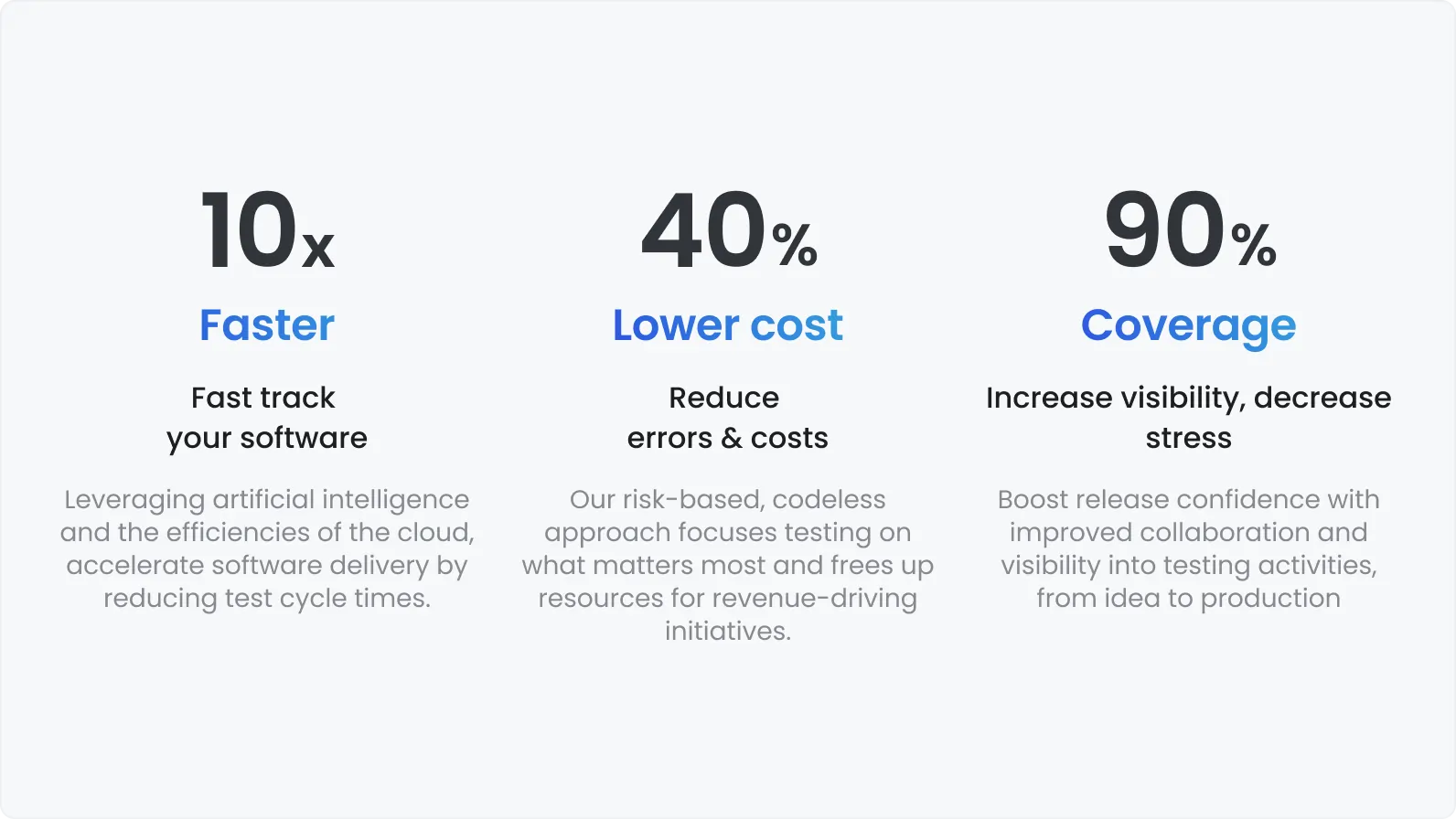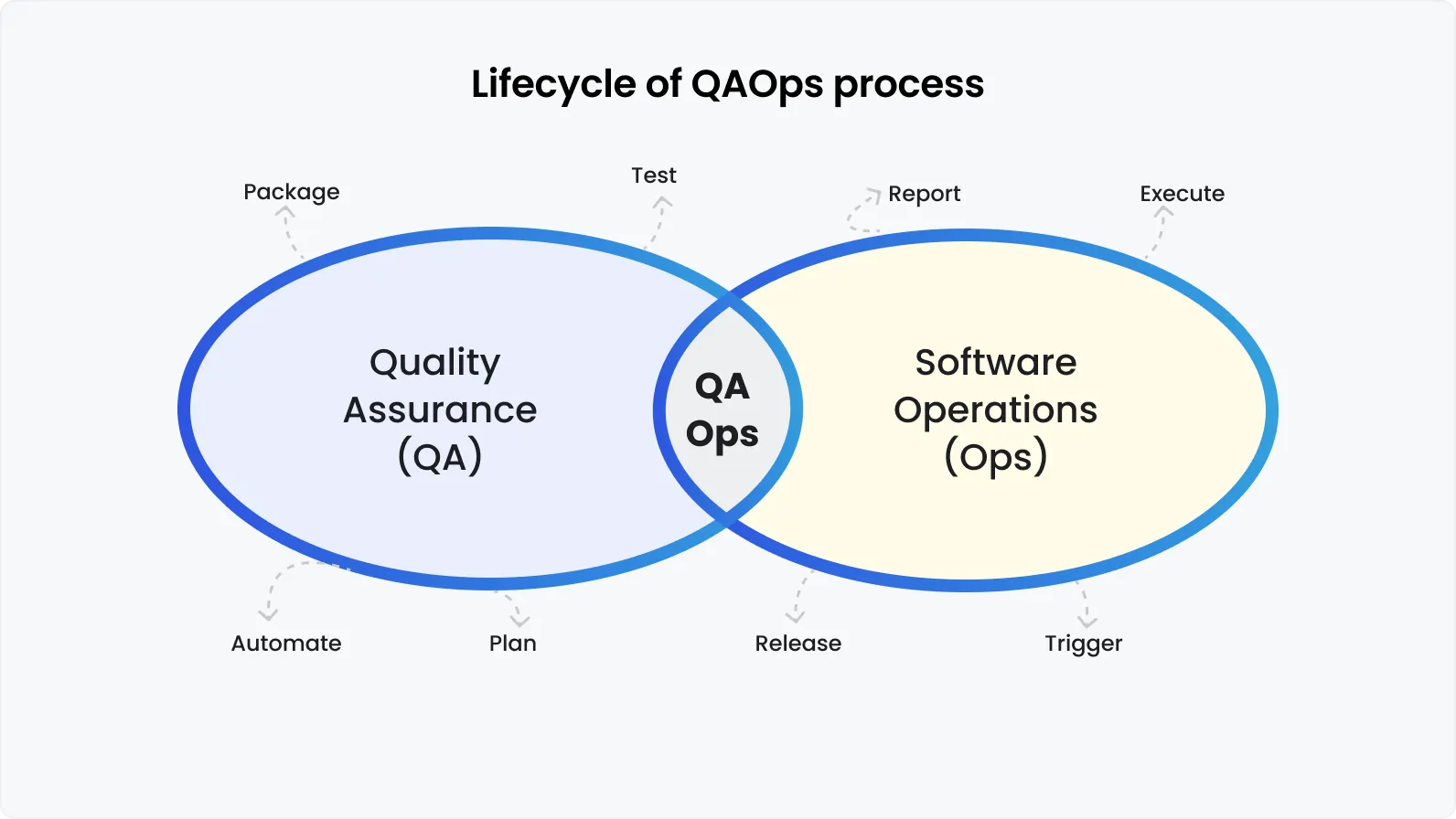9 minutes to read
The top 5 benefits of adopting QAOps for your business


Mykhailo Ralduhin
Senior QA Engineer

Software failures can cost a fortune. McKinsey found that such screws created a USD 2 trillion cybersecurity market as the first consequence of poor software is data loss. To avoid this, businesses must focus on quality assurance (QA). Meanwhile, Tricentis states that only 29% of mid-sized companies adopted QA automation.
This is where the benefits of QAOps, a mix of QA and DevOps, come into play. It's a new way to do QA that focuses on integration, automation, and continuous improvement.
Instead of separate last-minute testing, efficient quality assurance makes it a continuous part of development. In practice, this embodies quicker feedback, faster fixes, and better overall software quality.
Step by step, QAOps and software quality gain ground. In this article, we’ll look at the top five benefits of adopting QAOps and how QAOps impact on business can back up your company.
Benefit #1: Amplifier to your efforts
Metaphorically, QAOps is like the pit crew in a Formula 1 race. The crew acts lightning-fast to ensure a car is oiled and optimized to back on track in seconds. QAOps ensures that software development moves forward smoothly.
Quality assurance automation and continuous quality checks implemented directly into the development process drastically reduce the time it takes to identify and fix issues. This approach eliminates the bottlenecks that often occur when testing is left until the end of a project, allowing for a much faster and smoother software development lifecycle.
Why it works
QAOps isn’t equal to automation, yet the latter is a significant part of it. Here is why:
Faster feedback: This allows for rapid identification and resolution of defects, reducing the time spent on manual testing.
Continuous integration: This way, every code change is thoroughly and constantly tested, preventing issues from propagating to later stages.
Reduced rework: Early detection of defects prevents rework, saving time and resources, too.
An example: In a typical CI/CD pipeline, when a developer pushes code, automated tests are triggered instantly. If a test fails, the feedback is sent directly to the developer, who can then fix the issue before it affects the rest of the team.
Automating the entire process, QAOps helps teams release new features and updates more frequently. For example, Netflix started off with updates once every two to three days and has come to hundreds of updates every day.
How Monzo deploys 100 pieces of code daily
This example is few and far between since the DevOps philosophy isn’t so popular among banks. Yet, it’s still very interesting to know about. Monzo, one of the leading neobanks, showcases the impact of QAOps on speed and efficiency.
Embracing QAOps allowed Monzo to hire more devs as they saved resources due to test automation. Like Netflix, they deployed over 100 pieces of code every day and reduced their deployment time. A feature of their development and testing culture is the minimization of contention. With more devs, there is always a risk that changes from one specialist may block release from another. Collaboration is key… and a small unit of deployment.
Fast releases with confidence. Powered by QAOps
Benefit #2: Team up to get work done
Efficient quality assurance is a key element that connects the development and operations teams. Traditionally, these teams often work in silos, each focused on their specific tasks. QAOps makes a twist, creating a unified workflow.
Developers, testers, and operations specialists share responsibilities, understanding that quality is a collective priority. Such collective ownership fosters a culture where communication flows more freely, and issues are addressed collaboratively, rather than being cascaded from “more important” teams to “others”.
Why it works
Because QAOps promotes accelerating practices:
Integrated testing environments: Teams work in the same environment, which reduces misunderstandings and streamlines processes. Everyone knows what to expect because they’re all working within the same system.
Shared responsibilities: No more finger-pointing when something goes wrong as collaboration in QAOps is a cornerstone. The success of the software is a shared responsibility, so teams are more likely to build an effective process.
Real-time collaboration: With Slack or Jira, team members can communicate instantly, share updates, and resolve issues quickly. This real-time collaboration keeps everyone in sync and helps prevent bottlenecks.
How QAOps strengthens teams at Spotify
The global music streaming giant adapted QAOps practices years ago. Their modern product and approach embody their journey to a more collaborative and efficient software development process.
Key challenges:
1. Scaling operations: As of 2023, Spotify's user base bet over x2 Apple’s. There is nothing groundbreaking that the company faced challenges in maintaining a high-quality user experience and ensuring timely feature releases.
2. Complex codebase: At the very beginning, Spotify's codebase is vast and complex.

Results:
1. Improved quality: By integrating QA into the development process, Spotify was able to identify and fix defects earlier, leading to a higher-quality product.
2. Enhanced scalability: QAOps helped Spotify scale its operations efficiently, supporting a growing user base and expanding feature set.
Benefit #3: Software you are not ashamed of
QAOps is a net, catching bugs (pun is here). Continuous testing benefits allow software quality to be maintained throughout the development process. Capgemini states organizations that implemented continuous testing hit at least a 22% improvement in software quality. By detecting defects early, companies reduce the likelihood of bugs slipping into production.
Why it works
Catching bugs early is one of the core QAOps advantages:
Early defect detection: Identifying defects as soon as they appear allows teams to address issues before they expand. Consequently, you keep the codebase clean and reduce the risk of costly fixes later. As a bonus, you maintain a clear understanding of the codebase and dependencies for future teams as your business will be handed over sooner or later.
Continuous testing: Traditional in-the-end testing can cause teams anxiety. On the other hand, QAOps integrates testing into every phase of development and piece in the team’s mind.
Improved code quality: Immediate feedback on devs’ work enables them to make adjustments in real time.
How Microsoft improved software quality
Microsoft is a forerunner in many tech advancements. Their transition to QAOps is another proof of QAOps' impact on business.
After adopting QAOps practices, Microsoft even created a new role: TestOps. By integrating continuous testing and early defect detection into their enterprise software testing and development process, Microsoft maintained higher code quality and delivered more reliable software to its customers.
Benefit #4: Save money to make more money
QAOps drives down costs by streamlining the testing process and reducing the need for late-stage bug fixes. With automation and continuous quality checks, companies can minimize the expensive, time-consuming manual work that often bogs down traditional QA methods.
Forrester Research found that organizations adopting DevOps and QAOps practices can experience up to 30% reduction in development costs and a 20% increase in software quality.
Why it works
Cost savings with QAOps is a tangible result that happens due to appropriate process tuning.
Automation reduces manual workload: Repetitive tasks like regression testing can be automated, allowing QA teams to focus on more critical testing areas. This shift cuts down on labor costs and speeds up the testing process.
Early detection of defects: By catching issues during the development phase, QAOps prevents the costly rework required when bugs are found later. Early fixes are simpler and less disruptive, keeping the project on budget.
Better resource allocation: Automation frees skilled QA personnel to engage in complex testing and analysis, leading to more efficient resource use and a higher-quality product.
How Etsy achieved cost efficiency with QAOps
The famous marketplace has successfully leveraged QAOps to reduce costs and improve efficiency. Test automation and integrating QA into their DevOps pipeline allowed Etsy to achieve significant cost savings. While financial metrics are not open-source information, the company states they run about 14000 tests every day with the lion’s share of them automated and permanently tracked.
Benefit #5: Scalability and adaptability
If the process is built right and the flow is tuned, your project will scale. So will your team. And maintaining consistent quality across the software development lifecycle becomes challenging. Yet, you can take advantage of the scalability with QAOps.

Usually, there is a direct correlation between software complexity and team size. QAOps allows you to adjust without losing efficiency.
Why it works
QAOps is an agile approach, so is designed for complex processes.
Flexible test environments: QAOps allows for the creation of test environments that can be easily adjusted or replicated as needed. This flexibility ensures that testing keeps pace with development, even as projects grow more complex.
Automated scaling: With multiplying the number of tests, QAOps enables you without losing control. For example, Kubernetes can manage and scale test environments dynamically, ensuring that resources are used efficiently without manual intervention.
Seamless integration with new tools: Smooth integration is one of the main characteristics of QAOps. With new tools or processes, it is easier to adopt new technologies.
How Spotify scaled with QAOps
We already mentioned Spotify’s case above. Indeed, it’s a perfect example of how QAOps can support scalability. Doubling their user base year to year, the complexity of their software and the size of its development teams scaled.
And here QAOps practices assisted them in process efficiency. They used automated testing and flexible environments to handle an increasing number of users and features without compromising quality. This supported their rapid growth and allowed them to integrate new tools and processes seamlessly as they expanded.
To sum up
QAOps can serve as a door to a more stable and controllable flow of your company software processes. As you scale, leveraging the benefits of QAOps becomes almost a must-have thing:
Accelerated time-to-market: Streamlined development and testing processes allow faster software delivery.
Improved software quality: Higher quality products can become your calling card that potential clients will recognize you by.
Enhanced collaboration and communication: A collaborative environment among development, QA, and operations teams streamline the entire development cycle.
Reduced costs: Less is more, streamlined is clearer.
Scalability and adaptability: To handle growth, leverage appropriate tools and set workflows.
Our team is here to help you implement QAOps practices that will drive your business forward. Request a free 1-hour consultation to see how we can tailor our QAOps solutions to meet your needs.
Team up with an award-winning software QA and testing company
Trusted by 300+ clients worldwide



